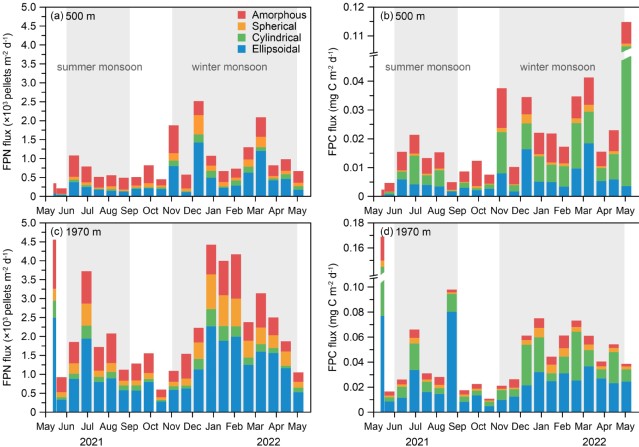Hanxiao Wang, Zhifei Liu, Jiaying Li, Baozhi Lin, Yulong Zhao, Xiaodong Zhang, Junyuan Cao, Jingwen Zhang, Hongzhe Song, and Wenzhuo Wang
State Key Laboratory of Marine Geology, Tongji University, Shanghai, 200092, China
Abstract:The sinking of zooplankton fecal pellets is a key process in the marine biological carbon pump, facilitating the export of particulate organic carbon (POC). Here, we analyzed zooplankton fecal pellets collected by two time-series sediment traps deployed on mooring TJ-A1B in the northern South China Sea (SCS) from May 2021 to May 2022. The results show a seasonal variability in both fecal pellet numerical (FPN) flux and fecal pellet carbon (FPC) flux, with peaks in November to April and June to August. It implies that the fecal pellet flux is largely regulated by the East Asian monsoon system. Vertical analysis further shows that FPN and FPC fluxes are higher at 1970 than at 500 m water depth, with larger pellets occurring in the deeper water, indicating a significant influence of mesopelagic and bathypelagic zooplankton community and lateral transport on deep-sea FPC export. However, the biovolume of amorphous pellets decreases significantly from 500 to 1970 m water depth, implying that these fecal pellets are broken and fragmented during the sinking process, possibly due to zooplankton grazing and disturbance by deep-sea currents. The contribution of fecal pellets to total POC export in the northern SCS is on average 3.4 % and 1.9 % at 500 and 1970 m water depth, respectively. This study highlights that the sinking fate of fecal pellets is regulated by marine primary productivity, deep-sea-dwelling zooplankton communities, and deep-sea currents in the tropical marginal sea, thus providing a new perspective for exploring the carbon cycle in the world ocean.
Full Article: https://doi.org/10.5194/bg-20-5109-2023


